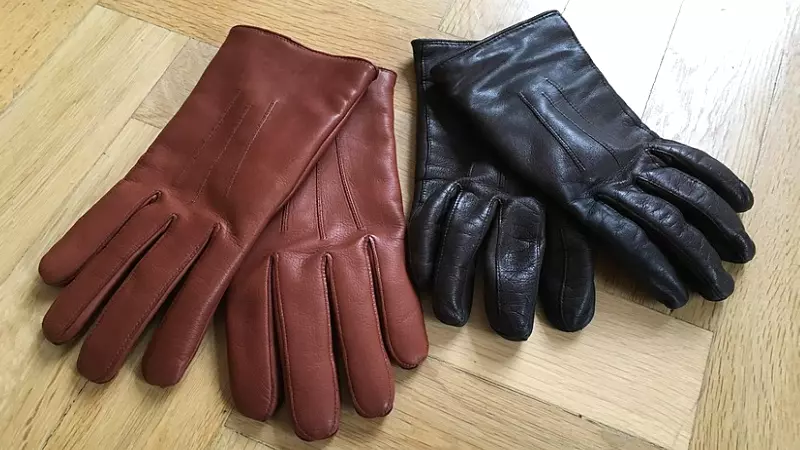How to Dye Your Leather Gloves in 5 Simple Steps
Leather gloves are not just used to accentuate an elegant look but are also used as protection against the cold and various work hazards. However, leather can be difficult to maintain since it can discolor and dry out easily when frequently used.
Dyeing will be able to reverse any effects of fading on your leather gloves and give them a brand-new appearance. Therefore, if you are looking to restore the color of your leather gloves or change it to a much more exciting color, you should consider dyeing them.
You can dye your leather gloves in just 5 simple steps:
- Prepare The Leather Dye
- Deglaze Your Leather Gloves
- Wash Your Leather Gloves
- Apply The Dye To Your Leather Gloves
- Seal The Dye
You should also note that the dyeing process is more than just simply applying color to your leather gloves. You’ll also need to ensure that they are cleaned, deglazed and that the leather dye is appropriately sealed.
Don’t worry! This guide will teach you how to dye your leather gloves using best practices and what to look out for. Let’s get started!
1. Prepare The Leather Dye
Cutting or diluting is essential in preparing the leather dye. We strongly recommend starting by diluting the dye before applying it to your leather gloves. The effect of diluting it is that you are creating a slightly lighter shade of the original color.
This will allow for multiple applications and coatings on your leather gloves, which we will cover in more detail later on in this article.
While you can achieve your desired color within one application without diluting the dye, we recommend multiple coatings in the application stage. Keep that in mind as you are preparing your leather dye.
Applying diluted coats can allow you to achieve your desired color and a more even coat. We recommend using the exact shade of dye that matches your leather gloves. If you cannot find an exact match, you should use a shade darker than the original for the best results as you can always dilute the dye down to the shade you are looking for.
As a general rule of thumb, we recommend a range of 70% (dye) – 30% (thinner) to 50% – 50% composition for your final dyeing solution. If you’re dyeing your leather gloves to another color, then this of course doesn’t apply and you can pick any type of color.
When it comes to dyeing leather gloves, we recommend using either a water-based dye, an alcohol-based dye, or an oil-based dye. In the next section, we’ll share some of the similarities and differences between them.
Water-Based Dyes
Water-based leather dyes are made of a mixture of resins that allow proper saturation of the leather fibers with the coloring substances. They also contain waxes and grease that maintain the suppleness of the leather without any odor and offer resistance against color rub-off.
Nevertheless, the penetration of water-based dyes is more complex; therefore, it takes a lot of time for the dyes to dry on the leather.
Alcohol-Based Dyes
Alcohol-based leather dyes are highly popular due to their quick penetration and drying on leather. The alcohol in these dyes evaporates away from the leather gloves, leaving the leather fibers dyed with coloring components.
However, these dyes cannot saturate deeply in leather and easily rub off over time. The quick-drying property of this dye can also cause the natural oils of the material to evaporate away, leaving it dryer and stiffer.
As we are looking at multiple applications of the dye, we tend to recommend staying away from alcohol-based dyes unless it is the only option that you have left available.
Oil-Based Dyes
Oil-based leather dyes have a fundamental base upon a pigment oil solution. The oil pigment allows for much better penetration of leather fibers, even though it takes longer to dry compared to alcohol-based dyes. The oil solution also helps maintain the leather’s original softness, and the resulting color is much more even than alcohol-based dyes.
If you have time to spare for the drying process, we recommend oil-based dyes as we have achieved the most satisfactory results with this type of dye when it comes down to coloring leather in general.
2. Deglaze Your Leather Gloves
After choosing the perfect leather dye and cutting it, you should deglaze your leather gloves. Deglazing leather gloves allow you to remove the existing finishing on the leather gloves and provide a much better base for the new dye application.
You can rub a deglaze on your leather gloves using a clean cloth to remove any dirt, grease, or additional paint layers. This will allow the new dye’s adhesiveness to last longer.
This step will also result in a more consistent look due to the ability for the dye to be applied more evenly and across a more consistent surface area. It is best to use a leather deglazing product off the shelf since it provides safe removal of paints and grime.
However, if you cannot find a high-quality deglazer, you can use a fine grit of sandpaper to remove any existing finishes on top of the leather surface. Lightly rub a fine grit of sandpaper (600 grit) on the leather (ensuring to reach all the nooks) to remove the most superficial layer of the gloves.
3. Wash Your Leather Gloves
After deglazing your leather gloves, you must wash your leather gloves to clear any impurities. Washing your leather gloves before the dye application ensures your dye applies smoothly on top of the surface and does not stick to the dirt or grime on the gloves instead.
You should not submerge the leather gloves underwater but use a water spray bottle for this step. You can also use saddle soap to clean your leather gloves thoroughly. Saddle soap is one of our favorite choices when it comes to cleaning any type of leather product.
For a more complete guide on how you can wash your leather gloves effectively, for more information. In this guide, we go in-depth on how to properly clean leather gloves.
4. Apply The Dye To Your Leather Gloves
For the leather dyeing step, you need to apply at least three coats for a natural, even finish. Take note of the instructions of application as you will need to account for the natural grain finishing of leather to ensure that you can get consistency in the color being applied.
Apply the first coat using a cloth or sponge in circular motions onto the leather surface and leave it to dry. The second coat on the leather must be applied diagonally to the right in a back-and-forth motion before being allowed to dry again.
The third coat will also be applied diagonally but to the left. This will ensure that the leather grain has been dyed in all directions.
Dyeing top-grain leather will always display its natural blemishes and spots, whereas full-grain leather can be correctly dyed without damaging its natural fibers. Based upon the moisture level of the leather, if it is wet or dry, can affect how well the color appears and spreads on it.
Keep the following in mind before deciding whether you want to apply your dye directly after the previous step of washing your leather gloves.
Wet Leather Dyeing
In general, wet leather dyeing is recommended only if you are already experienced with leather and paintwork. If the leather is wet before dyeing, the color can be pulled more evenly into the surface. Whilst this is a good thing, we are operating on the assumption that the leather is equally wet throughout its surface area.
If the made assumption is not true, dyes will naturally spread to the wetter areas of leather, resulting in a more concentrated coloring that will be visually apparent.
Keep in mind that dyes on wet leather will appear darker than what it actually is. As your gloves dry, you will notice that the shade of color you have introduced is slightly lighter than when you applied it.
Dry Leather Dyeing
Dyeing dry leather is relatively easier since you can easily see where the dye has been applied. You can also notice which spots need extra dye and if the dye has been absorbed into the surface.
As we are not introducing additional variables of moisture into the equation with dry leather dyeing, it is certainly an easier process to undertake and we recommend this to anyone who might not be fully confident about dyeing wet leather.
5. Seal Leather The Dye
After completely dyeing your leather gloves, you should move on to conditioning the leather gloves. This step is also essential in sealing the leather dye. However, you must let your leather dye fully dry first, before you apply any conditioner.
You can condition them using a leather conditioner to nourish and lubricate them with essential oils. Sealing the dye will prevent accidental color rub-off and offer a glossy or matte finish. After applying the seal, allow it to dry adequately before buffing it with a clean cloth.
Best Practices for Dyeing Leather Gloves
We also wanted to make sure that you take note of some of the best practices when dyeing your leather gloves. Understanding the points below will ensure that you achieve the best results possible.
- Use Only Leather-Friendly Dyes – Ensure that your dyes are designed for leather products. This is important, as leather bonds differently than other materials, and unsuitable dyes may wear off in the long run or even damage your leather gloves.
- Let Your Leather Gloves Dry – You’ll also need to make sure that your leather gloves properly dry after each step of the process. This includes after washing, deglazing, dyeing, and conditioning.
- Use Multiple Applications – As previously suggested, we recommend that you coat your leather gloves with multiple dye applications to better match the colors. This also allows you to gradually select the final color tone.
- Read the Dye Instructions – Certain dyes come with special instructions that you should always take note of. You may use the information in this article as a guideline, but always pay attention to the recommendations of the manufacturer for the best result.

About Matthew
Co-Founder, Editor-in-Chief & Writer At Leatherskill
I’m a leather enthusiast turned artisan. Apart from crafting leather products, I’m passionate about writing in-depth guides and reviews on all things leather!

